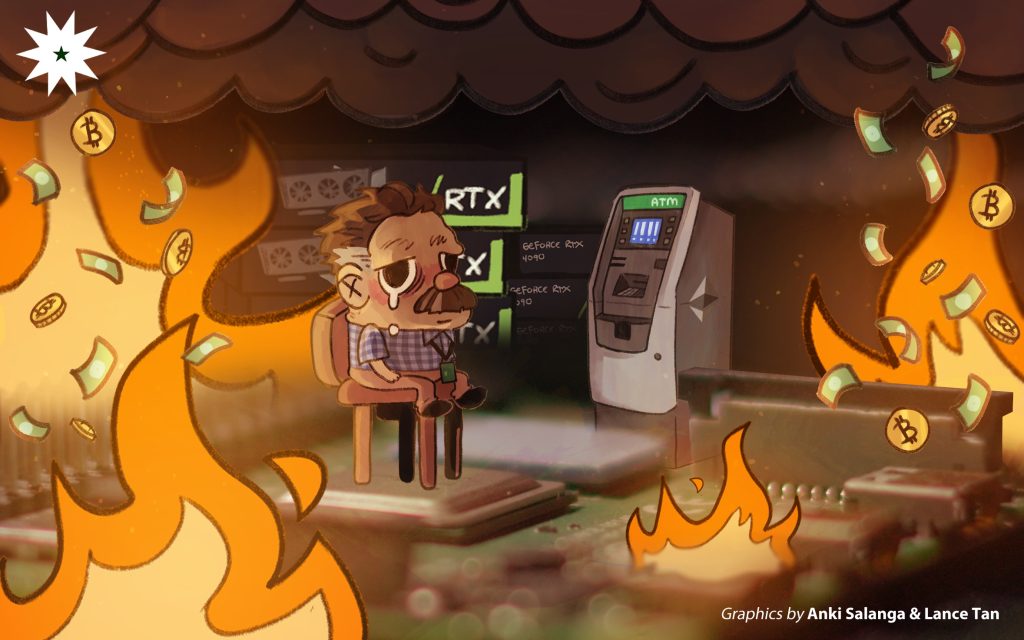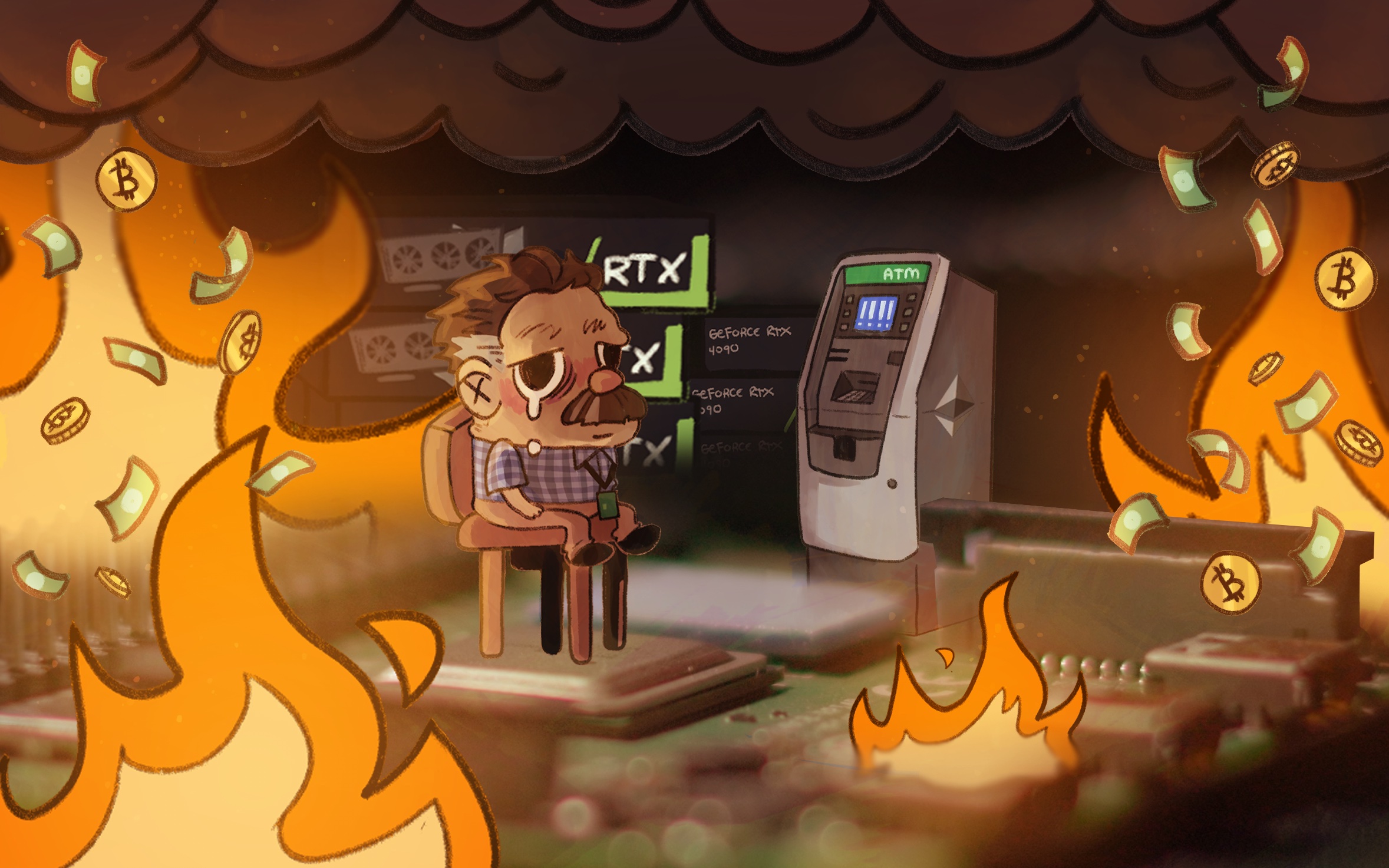This past January, De La Salle University (DLSU) adopted a radical new cryptocurrency mining program officially dubbed the Lasallian Campus Cryptocurrency Initiative (LCCI). Initially conceived as an undergraduate thesis by Magnus Akaw (IV, BS-BBM), the LCCI set out a plan to retrofit all desktop computers in the Manila campus into cryptocurrency mining rigs. Currently, the computers on campus are mining Ethereum with an NVIDIA RTX 4090 graphics processing unit (GPU).
Despite its initial promise, the LCCI is becoming increasingly unpopular among students, a sizable portion of whom have already signed a Change.org petition for its pause—if not complete cessation. With much at stake due to the nature of the LCCI, it is high time for it to be reexamined under a proverbial microscope: to gauge its merits against the weight of its flaws.

Power-hungry, possibly dangerous
One of the most pressing concerns about the LCCI is the increased power consumption brought about by the extra hardware required to mine cryptocurrency effectively. The RTX 4090 GPU in each computer has a power draw of around 250 watts (W) when mining Ethereum. With this number, The LuhSallian estimates that the increased power drawn from the computers in computer labs alone totals nearly 150,000 kilowatt hours (kWh) per month. Likewise, the power exhausted by the computers on campus exhaust would likely amount to a much higher figure.
This issue is further worsened by the fact that nearly all of the power that a computer draws is eventually converted into waste heat, making them essentially useful space heaters. All this extra heat has led to noticeably warmer classrooms and computer labs and, in response, higher power consumption for air conditioning.
Unsurprisingly, all of this extra stress on the University’s power grid has already manifested in random power outages and surges in buildings all over the Manila campus. There have also been two LCCI-related fires since the program started, one at the Science and Technology Research Center (STRC) and another at St. La Salle Hall. While the fires are still under investigation, the prevailing theory is that the fires were due to a combination of the power surges and faulty GPU power cables. The Student Discipline Formation Office, however, is not ruling out sabotage or arson, especially in light of the recent public disdain.
A measured response
In response to the backlash toward the LCCI, the University’s administration has released two transparency reports about the program. The first of the two confirms that there has been a large jump in the University’s electricity bill after the implementation of the LCCI—currently up 10 percent compared to the previous year’s average.
Moreover, in spite of student body concerns, the second report announced that the University will not stop the LCCI due to its “large profit margins” and instead asks students and professors to wear fewer layers of clothing and rely on electric fans to cut down on air conditioning costs.
However, many Lasallians have expressed their dismay against these reports as they have yet to recuperate from the mismanagement of the program. Ala Knukotulog (IV, BSCS) shares how their entire thesis group got delayed by another term as all their thesis progress was destroyed during the STRC fire. “You know, all that pancit canton was for nothing,” Knukotulog posits.
Xav D’ Ert (II, AB-PSM), the main organizer of the Change.org petition, believes that it is time for the University’s administration to heed the call of his fellow Lasallians and shut down LCCI. “The [admin] wants to shift to a full face-to-face setup, but our computers aren’t even working anymore. As if the issues with Canvas and Animo Connect weren’t enough,” D’ Ert expresses. Together with D’ Ert, the University Student Government (USG) has successfully brought the Lasallian community together in a weeklong strike against the LCCI at the Cory Aquino Democratic Space.
As many classes were disrupted by the noise, more and more professors canceled their onsite classes and allowed their students to join the protest against LCCI. The University administration made its first appearance on the fifth and last day of the strike, citing that the noise has been unbearable for days in Henry Sy Sr. Hall. The administration reportedly wanted to move their meetings to Br. Andrew Gonzalez Hall amid the strike, but feared losing valuable time in the long elevator lines.
A costly mistake
After multiple days of unabated student unrest and months of major financial setbacks, the University made the decision to cut its losses by putting an end to the LCCI and shutting down all existing computer labs and power outlets. All students will soon be mandated to bring their own laptops and power banks to compensate for the lack of school resources.
As a response to the current situation, a marketing campaign was initiated by Techtite and other e-gaming hubs around the University promoting discounts for DLSU students and professors who need computers for their labs and classes. Due to the adjusted price and the air-conditioned rooms, these e-gaming hubs have been packed 24/7, with people camping out as early as three in the morning to save a spot as soon as they open.
With DLSU facing these circumstances, the student body hopes that the administration will be wary of pursuing similarly risky programs and initiatives in the future. In an attempt to prevent disasters like this from happening again, the University has placed a non-negotiable ban on everything crypto-related from now until the end of time.



